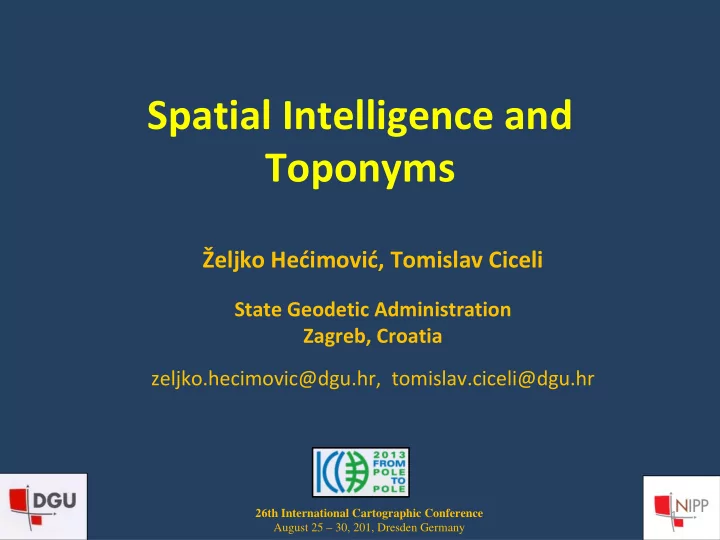

Spatial Intelligence and Toponyms Željko He ć imovi ć , Tomislav Ciceli State Geodetic Administration Zagreb, Croatia zeljko.hecimovic@dgu.hr, tomislav.ciceli@dgu.hr 26th International Cartographic Conference 1 August 25 – 30, 201, Dresden Germany
CONTENTS: I. Elements of the toponym's base of knowledge II. Spatial intelligence, thinking and reasoning III. Spatial intelligence and toponyms IV. Toponyms as spatial thinking tool V. Toponyms and ambiguous spatial reasoning VI. Conclusion and further development 2
I. Elements of the toponym's base of knowledge 3 Maurits Cornelis Escher
Definition of toponym UNGEGN: toponym ‐ proper noun applied to a topographic feature (Kadmon 2002). (Topographic feature ‐ a portion of the surface of Earth or of any other planet or satellite that has recognizable identity.) INSPIRE: geographical name (toponym of a feature on the Earth) ‐ proper noun applied to a real world entity (INSPIRE 2010). The International Council of Onomastic Sciences ( ICOS): toponym ‐ proper name of a place, both inhabited and uninhabited (Terminology Group ICOS 2010). • Definitions are newer ideal, but they are giving the main frame. For example, no time dimensions in the definitions! 4
• Toponyms are developed and used for centuries. • They reflect historical and cultural development of area. • They are defining not only features, but also individuals, groups and nations that are using them. • Toponyms are one of the most widely used tools in recognition of the place and orientation in space (spatial reasoning). • They can be used in spoken and written form. 5
II. Spatial intelligence, spatial thinking and reasoning 6 Maurits Cornelis Escher
• Intelligence is most widely studied in humans, but also has been observed in animals. • Artificial intelligence intelligence – based on machines/devices. • Virtual technologies are giving possibility of development of unique spatial relations and thinking/reasoning. • Brain activities can be interpreted as biochemical and electrical activities; e.g. tots, sensations of feelings, decisions, emotions, memory and other activities. • Spatial intelligence is the biological capacity that focuses on spatial judgment. 7
Howard Gardner the theory of multiple intelligences 1. Spatial intelligence ‐ deals with spatial judgment and the ability to visualize with the mind's eye. 2. Logical ‐ mathematical intelligence ‐ deals with logic, abstractions, reasoning and numbers. 3. Linguistic intelligence ‐ deals with words, spoken or written. 4. Bodily ‐ kinesthetic intelligence ‐ deals with control of one's bodily motions and the capacity to handle objects. 5. Musical intelligence ‐ deals with sensitivity to sounds, rhythms, tones, and music. 6. Interpersonal intelligence ‐ deals with interaction with others. 7. Naturalistic intelligence ‐ deals with relating information to one’s natural surroundings. 8. Existential intelligence ‐ deals with ability to contemplate phenomena or questions beyond sensory data, such as the infinite and infinitesimal. 8
• Spatial thinking is ability to use space as a framework for understanding, to define problems and give solutions. • We are learning to think spatially since we are born. • Spatial thinking is a part of everyday living. • Spatial thinking is a combination of cognitive skills: concepts of space, tools of representation and processes of reasoning. • Spatial thinking is an essential competence in a lot of branches like surveying, cartography, architecture and other. • No standardized measure of knowledge and skills of spatial thinking. 9
Spatial Reasoning Test – quantitative measurement 10
Spatial Reasoning Test 11
Practical examples of spatial intelligence 12
III. Spatial intelligence and toponyms 13
• Spatial intelligence is introduced by psychologists and sociologists. But, other branches as surveying, cartography, geoinformatics and other are giving contributions – toponyms point of view. • Semantics and ontological approaches are defining today theoretical background of spatial intelligence from geoinformation point of view – other branches have other backgrounds. • Spatial intelligence, spatial thinking and spatial reasoning are making new approach to spatial data systems and SDI. 14
• Maps, geographical names, GIS, SDI are tools used to help us in spatial thinking, reasoning and decision making process. • Spoken geographical names have been used as spatial thinking tool before maps and GIS. • Historically, the spatial thinking tools were developed from spoken geographical names, maps, GIS to SDI. • Systems, devices that help us in spatial reasoning – car navigation systems. 15
IV. Toponyms as spatial thinking tool 16
• Spatial reasoning using geographical names is the ability to extract position and orientation from geographical names. Elements of toponyms as spatial reasoning tool: • space (toponyms are elementar definition of space relations), • representation (verbal or written form and they are represented by language, writing system, pronunciation...), • reasoning (find position and orientation in space...). 17
V. Toponyms and ambiguous spatial reasoning 18
Some of the problems in spatial reasoning using toponyms: • the same noun can be used for different features, • the same feature has more names (official, not official...), • toponym is not uniquely defined (feature, georeferenced shape and noun), • endonym/exonim problems (Dunav, Danube....), • not unique writing system (Romanization system), • some countries have more official languages, • minorities languages and toponyms (official on the local areas), • dying of toponyms, people and languages. 19
Do you want to go to Berlin? Capital of Germany Settlement - Finland Region ‐ France 20
VI. Conclusion and further development 21
• Semantics and ontological approaches are defining theoretical background of spatial intelligence from geoinformation point of view – other branches other approaches. • Development of systems, devices that help us in spatial reasoning (car navigation systems) – spatial reasoning systems are using maps, toponyms, GIS and SDI as tools. • Toponyms are important spatial thinking and reasoning tools widely used in everyday life. • Toponyms could be ambiguous spatial reasoning tool. • Spoken toponyms have been used as one opf the first spatial thinking tool (before maps, GIS and SDI). • Spatial intelligence, thinking and reasoning is opening new areas in research and development. 22
Thank you for your attention! 23
Recommend
More recommend